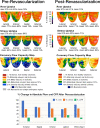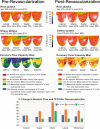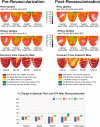PET Stress Testing with Coronary Flow Capacity in the Evaluation of Patients with Coronary Artery Disease and Left Ventricular Dysfunction: Rethinking the Current Paradigm
- PMID: 33761005
- PMCID: PMC7990801
- DOI: 10.1007/s11886-021-01478-3
PET Stress Testing with Coronary Flow Capacity in the Evaluation of Patients with Coronary Artery Disease and Left Ventricular Dysfunction: Rethinking the Current Paradigm
Abstract
Purpose of review: Cardiomyopathy with underlying left ventricular (LV) dysfunction is a heterogenous group of disorders that may be present with, and/or secondary to, coronary artery disease (CAD). The purpose of this review is to demonstrate, via case illustrations, the benefits offered by cardiac positron-emission tomography (PET) stress testing with coronary flow capacity (CFC) in the evaluation and treatment of patients with left ventricular (LV) dysfunction and CAD.
Recent findings: CFC, a metric that is increasing in prominence, represents the integration of several absolute perfusion metrics into clinical strata of CAD severity. Our prior work has demonstrated improvement in regional perfusion metrics as a result of revascularization to territories with severe reduction in CFC. Conversely, when CFC is adequate, there is no change in regional perfusion metrics following revascularization, despite angiographically severe stenosis. Furthermore, Gould et al. demonstrated decreased rates of myocardial infarction and death following revascularization of myocardium with severely reduced CFC, with no clinical benefit observed following revascularization of patients with preserved CFC. In a series of cases, we present pre-revascularization and post-revascularization PET scans with perfusion metrics in patients with LV dysfunction and CAD. In these examples, we demonstrate improvement in LV function and perfusion metrics following revascularization only in cases where baseline CFC is severely reduced. PET with CFC offers unique guidance regarding revascularization in patients with reduced LV function and CAD.
Keywords: Cardiac PET; Coronary flow capacity; Ischemic cardiomyopathy; Left ventricular dysfunction; Myocardial blood flow.
Conflict of interest statement
Robert M. Bober reports grants from Bracco Diagnostics, Inc. (
Figures




Similar articles
-
Positron emission tomography for the assessment of myocardial viability: an evidence-based analysis.Ont Health Technol Assess Ser. 2005;5(16):1-167. Epub 2005 Oct 1. Ont Health Technol Assess Ser. 2005. PMID: 23074467 Free PMC article.
-
Positron emission tomography for the assessment of myocardial viability: an evidence-based analysis.Ont Health Technol Assess Ser. 2010;10(16):1-80. Epub 2010 Jul 1. Ont Health Technol Assess Ser. 2010. PMID: 23074393 Free PMC article.
-
Regional, Artery-Specific Thresholds of Quantitative Myocardial Perfusion by PET Associated with Reduced Myocardial Infarction and Death After Revascularization in Stable Coronary Artery Disease.J Nucl Med. 2019 Mar;60(3):410-417. doi: 10.2967/jnumed.118.211953. Epub 2018 Aug 16. J Nucl Med. 2019. PMID: 30115688 Free PMC article.
-
Reliability and Reproducibility of Absolute Myocardial Blood Flow: Does It Depend on the PET/CT Technology, the Vasodilator, and/or the Software?Curr Cardiol Rep. 2021 Jan 22;23(3):12. doi: 10.1007/s11886-021-01449-8. Curr Cardiol Rep. 2021. PMID: 33483794 Free PMC article. Review.
-
Improved Performance of PET Myocardial Perfusion Imaging Compared to SPECT in the Evaluation of Suspected CAD.Curr Cardiol Rep. 2023 Apr;25(4):281-293. doi: 10.1007/s11886-023-01851-4. Epub 2023 Feb 24. Curr Cardiol Rep. 2023. PMID: 36826689 Review.
Cited by
-
Comorbidities and cardiac symptoms can modify myocardial function regardless of ischemia: a cross-sectional study with PET/CT.Arch Cardiol Mex. 2023 Jul 27;93(3):336-344. doi: 10.24875/ACM.22000088. Arch Cardiol Mex. 2023. PMID: 36194873 Free PMC article.
References
-
- Petrie MC, Jhund PS, She L, Adlbrecht C, Doenst T, Panza JA, Hill JA, Lee KL, Rouleau JL, Prior DL, Ali IS, Maddury J, Golba KS, White HD, Carson P, Chrzanowski L, Romanov A, Miller AB, Velazquez EJ, STICH Trial Investigators Ten-year outcomes after coronary artery bypass grafting according to age in patients with heart failure and left ventricular systolic dysfunction: an analysis of the extended follow-up of the STICH Trial (Surgical Treatment for Ischemic Heart Failure) Circulation. 2016;134:1314–1324. doi: 10.1161/CIRCULATIONAHA.116.024800. - DOI - PMC - PubMed
-
- Maron BJ, Towbin JA, Thiene G, Antzelevitch C, Corrado D, Arnett D, Moss AJ, Seidman CE, Young JB. Contemporary definitions and classification of the cardiomyopathies: an American Heart Association Scientific Statement from the Council on Clinical Cardiology, Heart Failure and Transplantation Committee; Quality of Care and Outcomes Research and Functional Genomics and Translational Biology Interdisciplinary Working Groups; and Council on Epidemiology and Prevention. Circulation. 2006;113:1807–1816. doi: 10.1161/CIRCULATIONAHA.106.174287. - DOI - PubMed
-
- Elliott P, Andersson B, Arbustini E, Bilinska Z, Cecchi F, Charron P, Dubourg O, Kühl U, Maisch B, McKenna W, Monserrat L, Pankuweit S, Rapezzi C, Seferovic P, Tavazzi L, Keren A. Classification of the cardiomyopathies: a position statement from the European Society of Cardiology Working Group on Myocardial and Pericardial Diseases. Eur Heart J. 2008;29:270–276. doi: 10.1093/eurheartj/ehm342. - DOI - PubMed
-
- Gould KL, Johnson NP, Bateman TM, Beanlands RS, Bengel FM, Bober R, Camici PG, Cerqueira MD, Chow BJW, di Carli MF, Dorbala S, Gewirtz H, Gropler RJ, Kaufmann PA, Knaapen P, Knuuti J, Merhige ME, Rentrop KP, Ruddy TD, Schelbert HR, Schindler TH, Schwaiger M, Sdringola S, Vitarello J, Williams KA, Sr, Gordon D, Dilsizian V, Narula J. Anatomic versus physiologic assessment of coronary artery disease: role of coronary flow reserve, fractional flow reserve, and positron emission tomography imaging in revascularization decision-making. J Am Coll Cardiol. 2013;62:1639–1653. doi: 10.1016/j.jacc.2013.07.076. - DOI - PubMed
Publication types
MeSH terms
LinkOut - more resources
Full Text Sources
Other Literature Sources
Medical
Research Materials
Miscellaneous

